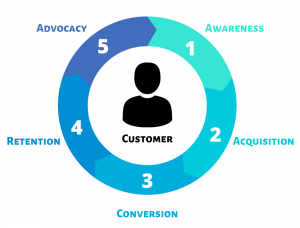
Stages of Customer Relationship Lifecycle
Awareness is the first stage of the lifecycle. Here, you work on reaching new customers as per their interest, i.e., making them aware of the existence of your brand and the products/services that you have to offer. In this stage, you try to capture your potential customer’s attention. This could be through various sources such as advertising, word-of-mouth, and social media, among others. You need to make sure all your marketing collaterals are in the right place with the right messaging, where you are able to reach your target audience in an effective manner. You need to have your market analysis-ready about the type of audience you wish to reach, along with the means to reach them. Analytics at this stage will help you understand where you are able to reach the correct audience more. Conversion to paying customers seldom happens at this stage. Your main aim here is to capture the customer’s attention and develop a relationship with them. This is the second stage in the lifecycle. The aim of this stage is clear – to convert the interested prospects to customers or subscribers. It is this stage that you have to be attentive to your customer’s needs. They are coming to you with some ideas and requirements in mind. You have to make them understand how you are their best option and how you can help them in the best possible way. It is imperative to understand as a company that if you don’t provide good service, customers will find a solution according to their requirements from someone who provides a better service than you. Not replying to their emails, not returning their phone calls, or taking too long to get back to them with a solution could all end up discouraging your prospect to invest with you. After you have gained your prospect’s attention and providing a satisfactory pre-buying experience, it is likely that some of your leads will turn into paying customers. This is where your sales skills are put to the test. Instead of concentrating on selling the product, you need to build a good rapport with the leads and imbibe in them a sense of trust with your brand. Loyal customers are happy customers. Successful businesses concentrate on retaining their customers rather than acquiring new ones all the time. It is necessary to nurture your relationship with the customers and not give them a chance to explore other options from different brands. Another reason being, the cost of acquisition is more than the cost of retention. The process of retention involves cultivating a relationship with your customers, responding to their queries on time, providing proper support, sending follow-up emails, etc. You should do everything to make your customers feel valued. An email during the festivals regarding new products that you have or giving them a discount on existing ones as a loyalty bonus, could make them happy and feel valued. It also makes your name pop-up in front of them from time to time reminding them of you. After the retention stage is achieved, you would want your customers to advocate your brand. A person is most likely to recommend your brand to their peers if they are satisfied with the service they have received. People are also more likely to buy from a brand that their friends/family/colleagues have recommended, as there is an extra trust factor of someone else who has tried it before.

0 Comments